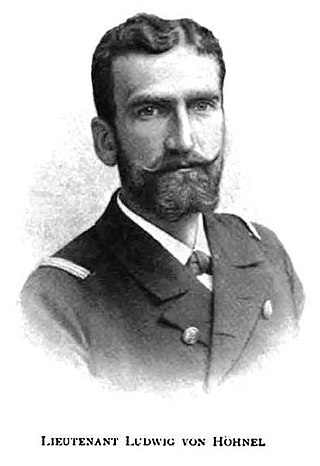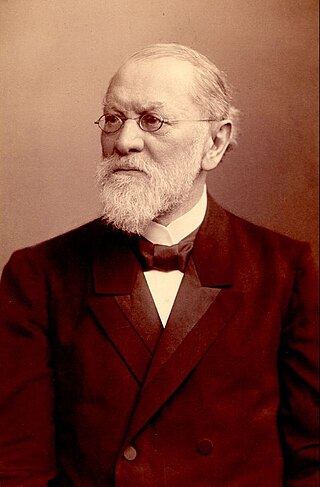Related Research Articles

Ludwig Ritter von Höhnel was an Austrian naval officer and explorer. He was trained at the naval academy in Fiume, then part of the Austrian empire. His brother was the naturalist Franz Xaver Rudolf von Höhnel (1852–1920).

Nathanael Pringsheim was a German botanist.
Pringsheimiella is a genus of green algae, in the family Ulvellaceae.
Hysteropezizella is a genus of fungi in the family Dermateaceae. The genus, first described by F. von Höhnel in 1917, contains 19 species.
Koordersiella is a genus of fungi in the class Dothideomycetes. The relationship of this taxon to other taxa within the class is unknown.
The Polystomellaceae are a family of fungi with an uncertain taxonomic placement in the class Dothideomycetes.
Keissleriella is a genus of fungi, that was originally placed in the Massarinaceae family, before being placed in the Lentitheciaceae family.
Lambertella is a genus of fungi in the family Rutstroemiaceae.
The Cephalothecaceae are a family of fungi in the class Sordariomycetes. The family was circumscribed in 1917 by Austrian naturalist Franz Xaver Rudolf von Höhnel. Species in this family are saprobic, often growing on rotten wood or on other fungi. They are known to be distributed in northern temperate regions. The family was placed in a monotypic class CephalothecalesHubka & Réblová in Index Fungorum 424: 1 (2019).

Poronidulus is a fungal genus in the family Polyporaceae. It is a monotypic genus, and contains the single polypore species Poronidulus conchifer, found in North America. The genus was circumscribed by American mycologist William Alphonso Murrill in 1904. The generic name, which combines the Ancient Greek word πόρος ("pore") with the Latin word nidulus, refers to the superficial similarity of the cup-shaped Poronidulus fruit bodies with those of the genus Nidularia. A second species, Poronidulus bivalvis, found in Bogor, was placed in the genus by Franz Xaver Rudolf von Höhnel in 1914. The actual identity of this taxon, however, is uncertain.
Limacinula is a genus of fungi within the Coccodiniaceae family. The genus was first named by Franz Xaver Rudolf von Höhnel in 1907.
Aeruginospora singularis is a species of fungus in the family Hygrophoraceae. The species, described by Franz Xaver Rudolf von Höhnel in 1908, is found in Indonesia. The type specimen of this species was found growing in soil under bamboo at the Bogor Botanical Gardens, and it has been found there twice since then.
Franz Xaver Rudolf von Höhnel was a bryologist, mycologist, and algologist from Austria-Hungary. He was a brother of explorer Ludwig von Höhnel (1857–1942). He obtained his PhD in Strasbourg in 1877, and was a professor of botany in the Vienna University of Technology from 1884 to 1920. Höhnel described roughly 250 new genera and 500 species of fungi, and was known for his contributions to the taxonomy of the Coelomycetes. He died in Vienna on November 11, 1920.

Trioceros hoehnelii, commonly known as von Höhnel's chameleon, the helmeted chameleon, and the high-casqued chameleon, is a species of chameleon, a lizard in the family Chamaeleonidae. The species is endemic to eastern Africa.
Anton Heimerl was an Austrian botanist.
Höhnel is a surname. Notable people with the surname include:
The Coronophoraceae are a family of fungi in the Ascomycota, order Coronophorales. The family was described by Austrian mycologist Franz Xaver Rudolf von Höhnel in 1907.
Entylomella is a genus of smut fungi in the family Entylomataceae. The genus, which contains anamorph forms of Entyloma species, was circumscribed in 1924 by Franz Xaver Rudolf von Höhnel.
Viktor Litschauer was an Austrian mycologist.
Ceratosporella is a genus of fungi. Some species interact with species of trees in the families Betulaceae and Fagaceae. Ceratosporella disticha can be isolated from decaying leaves of the palm Arenga westerhautii in Malaysia.
References
- ↑ Studien über Hyphomyzeten. Höhnel, F. von, 1924, Zentralblatt für Bakteriologie und Parasitenkunde Abteilung 2. 60, pages 1-26
- ↑ Fünfte vorläufige Mitteilung mycologischer Ergebnisse (Nr. 399–500). F. von Höhnel, Berichte der Deutschen Botanischen Gesellschaft, volume 37, page 155 (1919)
- ↑ Two new species of Ceratosporella (anamorphic fungi) from Brazilian Amazon forest. Luis Fernando Pascholati Gusmao and Josiane Monteiro, Nova Hedwigia, 98(3-4), page 481, February 2014, doi:10.1127/0029-5035/2014/0165